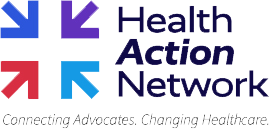Big Pharma’s “hidden hand” influence over patient advocacy groups comes to light; telehealth helps address disparities – but, gaps remain; stakeholders continue to focus on addressing health inequities; and, safety net programs celebrate an important anniversary.
We encourage you to stay involved as implementation efforts surrounding healthcare reform progress. Visit the Health Action Network and be sure to let us know what’s on your mind.
Item of the Week

Week in Review
Big Pharma Influence: A new report shines a light on the financial levers and tactics used by Big Pharma to influence patient advocacy groups. Released by Patients for Affordable Drugs, the report exposes the intricate and hidden web of money and influence deployed by the drug industry over decades reaching deep into organizations and groups representing (or purporting to represent) patients, creating conflicts of interest and constraining their ability to advocate on critical drug pricing reform issues. In identifying some of the most recognizable names in the patient advocacy space – many of whom, in addition to taking millions from drug companies every year, also fail to disclose these relationships – the report’s authors point out that these groups often fail to take positions on consumer issues that might upset their corporate drug funders.

Telehealth: Of the numerous vulnerabilities in our healthcare system exposed by the coronavirus pandemic, access issues were undoubtedly near the top of the list. While some of those challenges were immediately remediated by the broad expansion of telehealth, other, more systemic challenges have proven to be less easily addressed, such as health equity issues. A new study takes a closer look at how those challenges have been impacted by patients’ utilization of telehealth during the ongoing public health crisis. According to the data released by Anthem, different populations adopt telehealth at different rates for different reasons. This helps to underscore that a single approach to addressing health-related social needs is not the most effective strategy. But, while acknowledging that telehealth might not be the end-all solution to eliminating gaps in health equity, the study did highlight the undeniably critical role it played to boost connectivity and make healthcare visits and the delivery of services even possible during the pandemic.
Health Inequities: On a separate but related note, healthcare stakeholders continue to turn their attention to better addressing health inequities – this includes payers, who’ve also focused their energies on bridging the health disparities gap, particularly as they intersect with health-related social needs. In specific areas, such as prevention and wellness, population health, and data analytics, insurers have looked to capitalize on this moment to ensure that vulnerable and disadvantaged communities are able to enjoy the same access to care as everyone else. This has also seen payers broaden their focus to include an emphasis on mental and behavioral health in their programmatic benefits design.
56thAnniversary of Medicare and Medicaid: Last month marked the 56thanniversary of the passage of the law establishing the Medicare and Medicaid programs. Signed by President Lyndon B. Johnson on 30 July 1965, that law resulted in the creation of these critical safety net programs whose express purpose is to ensure that the most vulnerable Americans have access to the healthcare they need. In fact, since its creation, the Medicaid program has become the largest single source of healthcare in the country, providing coverage to more than 70 million people – or, one out of five Americans. Meanwhile, Medicare has continued to bring important innovations to seniors across the country, such as the Medicare Advantage program, which connects millions of beneficiaries to high-quality, affordable, coordinated care.


| You can keep up with the latest by following the Health Action Network on Twitter and by liking us on Facebook. And, be sure to check us out on LinkedIn, too. As always, let us know if there’s something you’d like to see covered in a future newsletter. |
